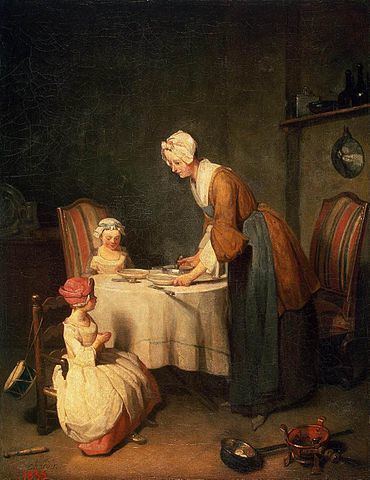Year c. 1740 Dimensions 50 cm x 38 cm Media Oil paint | Medium Oil on canvas Location The Louvre Period Baroque | |
 | ||
Artist Jean-Baptiste-Siméon Chardin Genres Genre art, History painting Similar Jean-Baptiste-Siméon Chardin artwork, Artwork at The Louvre, Oil paintings | ||
Obra comentada le b n dicit la bendici n chardin
Le Bénédicité (English: Grace) is a painting by the French artist Jean-Baptiste-Siméon Chardin. Chardin made several versions of the painting, one of which was given as a gift to Louis XV. The subject of the painting is one of bourgeois, everyday tranquillity – Chardin's field of expertise, with an uncharacteristic touch of sentimentality.
Contents
History
Chardin, who had made his fame painting still life, had at this point in his career started also to include human figures in his works. He painted several versions of Le Bénédicité, three of which were exhibited at the Salon, in 1740, 1746 and 1761. The original, from 1740, was given as a gift to the King. The painting fell into oblivion ten years after the death of Louis XV, but was rediscovered in 1845. Another version was kept by the artist throughout his life, and eventually ended up in the Musée du Louvre, through the large bequest of Louis La Caze in 1869. The version from the 1761 Salon – a horizontal composition – is now lost.
The painting
Chardin is well known for his depictions of humble, everyday life. Le Bénédicité shows a modest, middle-class interior scene, where a mother is laying the table for a meal. She instructs her children to say their grace before eating. The younger of the children can easily appear a girl to the modern eye, if the drum hanging on the child-sized ladderback chair is overlooked, and is indeed identified as such in Gardner. Rand and Bianco, however, quote the inscription on a contemporary engraving, describing the child as a boy, who has not yet been breeched. The quiet, peaceful atmosphere is reinforced by the subdued colour scheme, and the muted lighting. Chardin put much work into the arrangement of the various elements of his paintings. The composition here is meticulous, and the stability created by the triangular structure of the three figures also adds to the tranquillity of the scene.
Reception
Chardin is often contrasted to Watteau, whose paintings of aristocratic life differ greatly from those of Chardin's common people. It is not known for certain whether Le Bénédicité was painted with Louis XV in mind, or if it was the king who personally picked the painting out from the 1740 exhibition. In either case, the purchase shows the appeal the painting had to its contemporaries. When it was rediscovered in 1845 – on the eve of the revolutions of 1848 – it had taken on a whole new meaning. To the bourgeois establishment, the works of Chardin now represented a salutary contrast to the 'decadent aristocratic flimsy' of Watteau. In 1848, an anonymous reviewer in the journal Magasin Pittoresque wrote:
